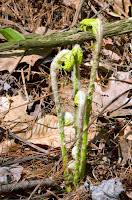Tuesday, April 17, 2012
Ostrich & cinnamon fern fiddleheads, false hellebore popping up
What: I noticed a few very young patches of ostrich fern fiddleheads, Matteuccia struthiopteris (pictured first) coming up along Wool Pullery Brook. Cinnamon fern (Osmunda cinnamomea) ** This was mislabled by me and is actually interrupted fern. IF has sporangia on the fronds - see first image - while CF has separate fertile fronds. Also, CF has a more orange color while IF is whiter ** was also coming up (second photo); I'm not sure, but I believe that the two small fiddleheads at the base of the much taller ones are the fertile fronds - I'll have to go back to double check. It's been extremely dry here the past couple of weeks and the water table is much lower than I'd expect in April. But the 80degree weather has pushed a lot of plants up and the aspen leaves in particular are a beautiful lime green. Also mixed in with the ostrich fern was false hellebore (Veratrum viride), in the lily family, trillium family, or Melanthiaceae.
Ecological notes: I don't know exactly what the chemical that causes it is, but the false hellebore smelled a lot like Italian herb bread crumbs. My theory on the strong smell (e.g. skunk cabbage) and toxicity (e.g. blue cohosh) of many spring ephemerals is as a defense against all those half-starved animals that made it through the winter and are looking for the first green vegetables. Might not be a big deal for larger mammals like us or deer, but the ptaquiloside in bracken fern, glycosides in marsh marigold, or caulophyllosaponin in blue cohosh, but to mice, squirrels, insects and other leaf eaters they would be toxic. There might be a strong selective pressure for early plants to equip themselves disproportionately to fend off hungry mouths.
Where: The ostrich fern seemed to be slightly higher up from the river than the false hellebore, maybe slightly dryer here. The hellebore seems to prefer slightly shadier spots as there are plenty of other stretches of the brook that are similar in other ways except exposure. The patch photographed has been around for at least 4 years, but it's downstream from the most recent beaver pond so the hydrology of the bank hasn't really changed in that time.
Subscribe to:
Post Comments (Atom)

.JPG)

.JPG)




No comments:
Post a Comment